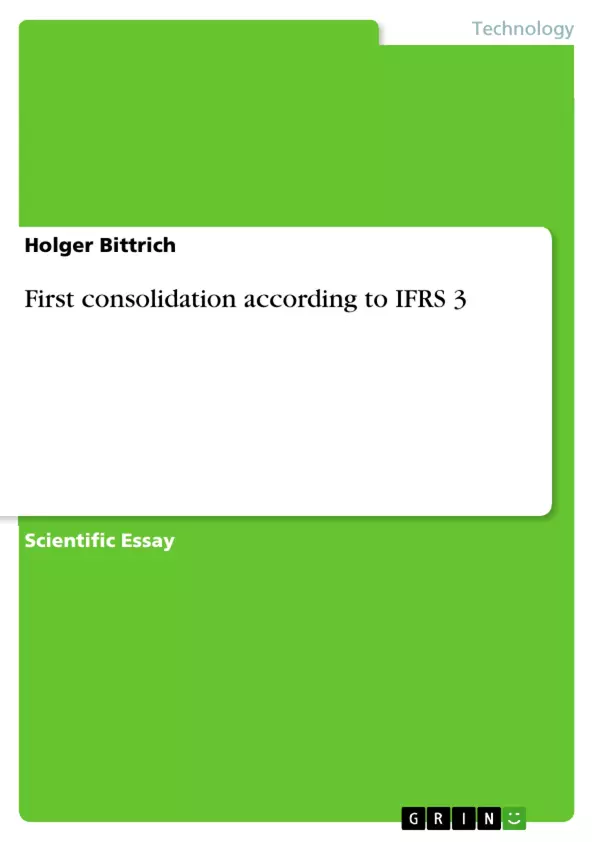As already described only those assets and liabilities are to be shown in the course of a business combination which fulfil the criteria of IFRS 3 on the acquisition date.
Assets and liabilities are recorded in their entirety at fair value, independent of the participation ratio of the parent company. For this reason the method is also described as complete revaluation.
The part of goodwill that relates to minority shareholders is always excepted from the capitalisation according to IFRS 3. However, in 2005 IASB suggested bringing the full goodwill onto the balance sheet i.e. not to eliminate the minority portion (so-called full goodwill method). With this method of complete revaluation as per IFRS 3 the net identifiable assets, over which the acquirer has obtained control, result from the fair values at the time of acquisition, i.e. at the time at which the acquirer obtained control independent of whether the purchaser acquired the entire capital, only a part of the capital or even just the net assets of the subsidiary company.
For the minority interests an adjustment item has to be recorded in this case. The adjustment item corresponds to the portion, at fair value, that these shareholders have of the net assets and debts.
Inhaltsverzeichnis (Table of Contents)
- Breakdown of purchase costs of the acquisition.
Recording and valuation of a balancing amount.. -
- Positive balancing amount
- Negative balancing amount
- Recording and valuation errors of acquisition cost or of assets and
liabilities, or valuations based on a standard which does not require a
valuation at fair value.
Zielsetzung und Themenschwerpunkte (Objectives and Key Themes)
This text provides a comprehensive overview of the accounting treatment of goodwill and bargain purchases under IFRS 3. It aims to clarify the valuation and recording process for both positive and negative balancing amounts arising from business combinations.- Goodwill accounting under IFRS 3
- Valuation of assets and liabilities at fair value
- Treatment of positive and negative balancing amounts
- Recording and valuation errors
- Bargain purchase accounting
Zusammenfassung der Kapitel (Chapter Summaries)
Breakdown of purchase costs of the acquisition.
Recording and valuation of a balancing amount..
This section introduces the concept of complete revaluation under IFRS 3 and discusses the recording of assets and liabilities at fair value. The text highlights the importance of identifying and valuing all assets and liabilities of the acquired company on the acquisition date. It also discusses the treatment of goodwill arising from the acquisition.
Positive balancing amount
This section explains the calculation and recording of goodwill as a positive balancing amount. It discusses the allocation of goodwill to controlling and minority shareholders and emphasizes the importance of fair value measurement for all assets and liabilities.Negative balancing amount
This section focuses on the treatment of negative balancing amounts, also referred to as bargain purchases. It explains how to identify and address the causes of a negative balance, including errors in valuation or recording, and provides guidance on the accounting treatment of such situations.Recording and valuation errors of acquisition cost or of assets and
liabilities, or valuations based on a standard which does not require a
valuation at fair value.
This section addresses potential errors in the valuation and recording of acquisition costs and assets and liabilities. It highlights the importance of re-examining the purchase price allocation and the valuation of assets and liabilities in case a negative balance is identified. The text provides examples of potential causes for a negative balance and outlines the proper accounting treatment.
Schlüsselwörter (Keywords)
This text focuses on accounting for goodwill and bargain purchases under IFRS 3. Key concepts covered include business combinations, fair value, acquisition date, acquisition costs, identifiable assets, liabilities, goodwill, negative goodwill, bargain purchase, purchase price allocation, and valuation errors.- Quote paper
- Holger Bittrich (Author), 2009, First consolidation according to IFRS 3, Munich, GRIN Verlag, https://www.grin.com/document/121003



